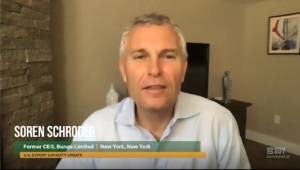The U.S. Soybean Export Council (USSEC) hosted a unique two-day global digital event on April 14 and 15, 2020. A first-of-its-kind event, the U.S. Soy Connection: Global Digital Conference and Situation Report showcased that the U.S. soy industry is open for business despite the global impact of the COVID-19 virus. More than 1,600 customers and soybean industry representatives from 84 countries participated in the digital conference.
Face-to-face relationships are a hallmark of the U.S. soybean industry and USSEC and the entire U.S. Soy family are working to maintain close contact with key stakeholders through technology during this period of social distancing. Connecting virtually is a seamless and nearly effortless way of communication.
One goal of the conference was to demonstrate how the 2020 planting season is moving forward, which allowed customers to see how U.S. agriculture will continue to produce high-quality, reliable, and sustainable products for global end-users. The event helped to sustain and further grow relationships between U.S. soybean farmers and their customers around the world.
“As we continue to navigate these unprecedented times, it’s more important than ever that we demonstrate to current and potential international customers the strength of our farmers and benefits of buying U.S. Soy,” said Jim Sutter, USSEC CEO. “USSEC has quickly adapted and changed tactics so we can show customers that our entire supply chain is working to ensure a sustainably and safely produced, reliable supply of soy for global customers. Throughout the conference, we showcased that despite the global impact of coronavirus, the supply of U.S. Soy remains unwavering.”
The conference highlighted the ongoing commitment to soybean production and delivery.

“Spring is planting season and as farmers, we have a responsibility to continue our job no matter what obstacles we face,” said Monte Peterson, a soybean farmer from North Dakota who serves as USSEC chairman and a director for the American Soybean Association (ASA). “Farmers have always been resilient in challenging situations, and this time is no different. And because 60% of our soybean crop is exported, we depend on strong partnerships with our global customers. That is all is part of the U.S. Soy Advantage.”
During the conference, participants received practical information about the industry from industry representatives, stakeholders, and U.S. soybean farmers.
- Thomas Mielke, executive director of ISTA Mielke, shared reflections on global supply and demand in light of the pandemic.
- Emily French, managing director at ConsiliAgra, discussed the implications of black swan events on the global soy marketplace.
- A panel of four U.S. soybean farmers from various geographic regions of the U.S. provided a spring planting outlook.
- A panel of representatives from exporter companies highlighted U.S. ability to meet global export demand.
On April 14, the first day of the conference, global experts discussed soybean trends and the impact of COVID-19.
“There’s no question that its agriculture that makes the world go around,” said French of ConsiliAgra. “Global agriculture continues to do what it does best, and that is feed and nurture the world. As we move through COVID-19, the value of free and reciprocal trade has never been more evident.”
Mielke shared indicators that trade is likely to increase during 2020. He said the Chinese soybean crush has exceeded expectations for the first half of the 2019-20 crop year, and that soybean meal demand is starting to increase compared to a year ago.
“In China, imports of soybeans are recovering,” he said. “We expect China to resume purchases of U.S soybeans in the coming weeks while Brazil exports (after record shipments in March and April) will start declining from May onward.”
On April 15, the second day of the conference, U.S. farmers and exporters described how they are ready and able to meet global demand. Between 2020 planting plans and the reliability of U.S. export logistics, U.S. Soy is positioned to deliver through the COVID-19 pandemic.

“I think everybody’s pretty optimistic about this year as far as getting started,” said Doug Winter, a U.S. soybean farmer from Illinois who serves as vice chairman of USSEC and on the United Soybean Board (USB). “We’re pretty much entertained full-time this time of year getting equipment ready, and getting seed all lined up, and getting everything organized for the planting season. We have a plan in place in case we have an employee that would happen to be infected with the COVID-19 virus, but we’re pretty self-contained and insulated out here.”
He added that working with customers is a high priority. “The communication around marketing, the quality of crop, and learning the needs of our buyers all work together to help us as farmers support our customers and make better decisions,” he continued. “Whether meeting in person or virtually, it helps us align on a common goal to increase the effectiveness and efficiency of soy.”
Other farmers echoed Winter’s optimism and expectations to produce a quality crop in 2020.
The reliability of U.S. infrastructure was highlighted by the final panel.

“Disruptions can take many forms for crops such as the global crisis that we’re experiencing now,” said Soren Schroder, former CEO of Bunge Limited. “The U.S. capacity runs on all coasts with highly efficient multi-modal interior logistic systems which ensure a continuous supply. Both interior and export terminals are highly automated making them more resilient. In short, the U.S. supply chain can be relied upon like no other.”
Exporters joining Schroder on this panel reinforced that soy is moving throughout the U.S. And all companies have plans in place to protect the health and safety of their workers, as well as crisis and contingency plans should a link in the chain be disrupted.
Sutter added, “Through the current uncertainties, we are committed to continued collaboration with our customers in new ways. Working together is the key to mutual success.”
U.S. soy products are available at a competitive price while maintaining the safety and quality standards customers have come to expect. This industry has not been directly impacted by the novel coronavirus. U.S. Soy is open for business.
